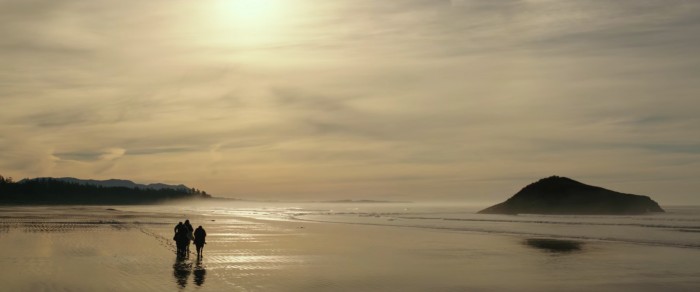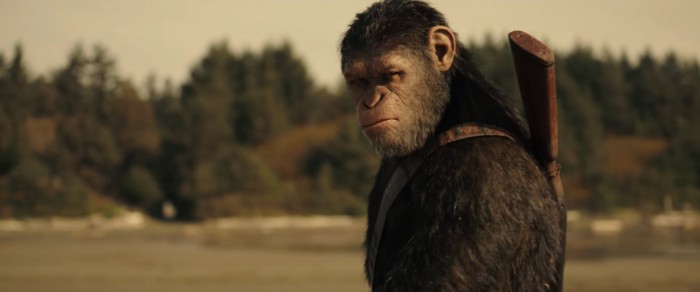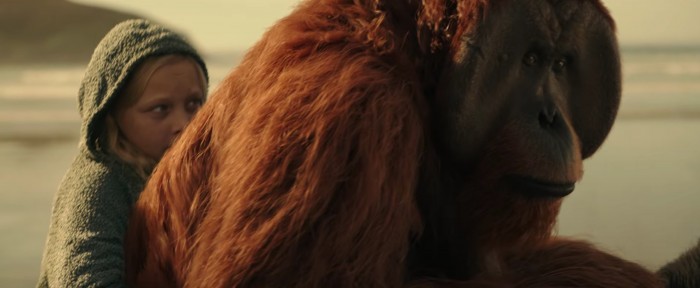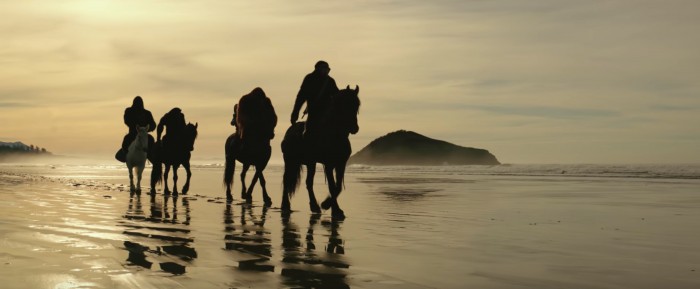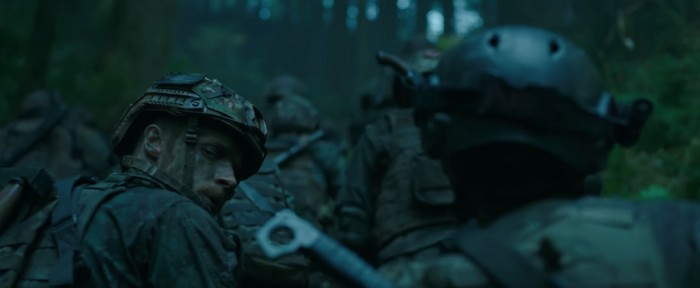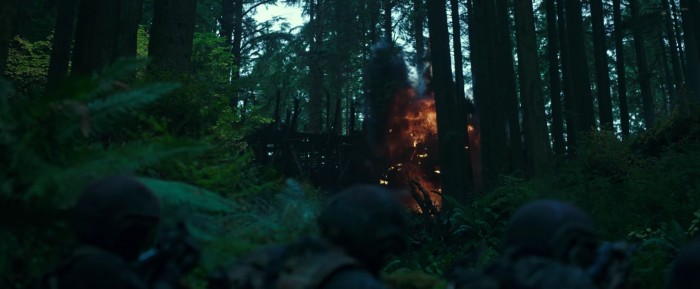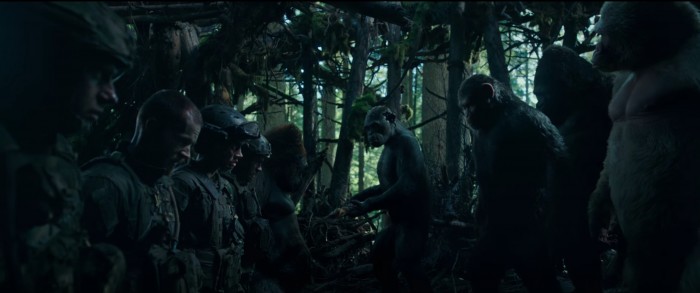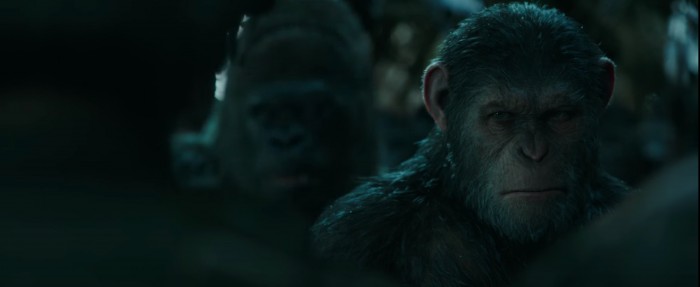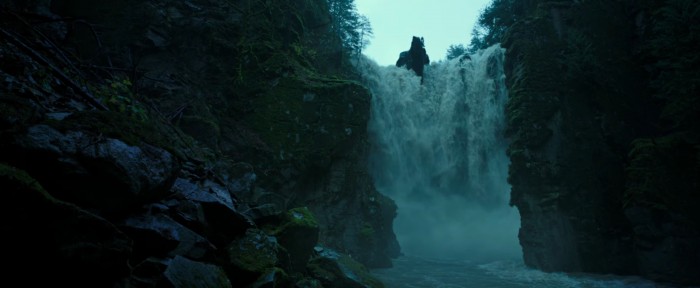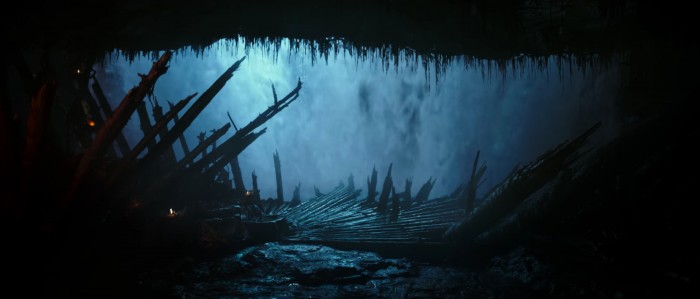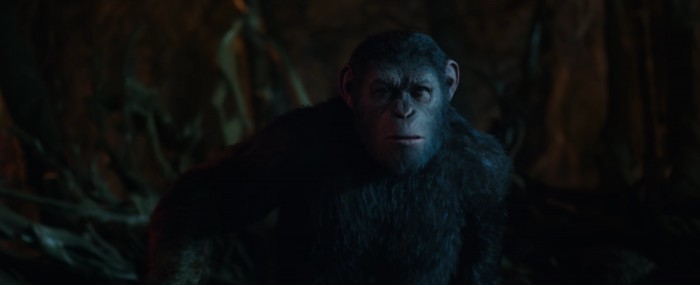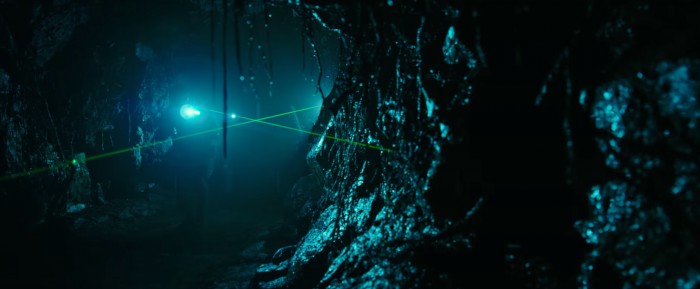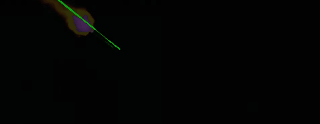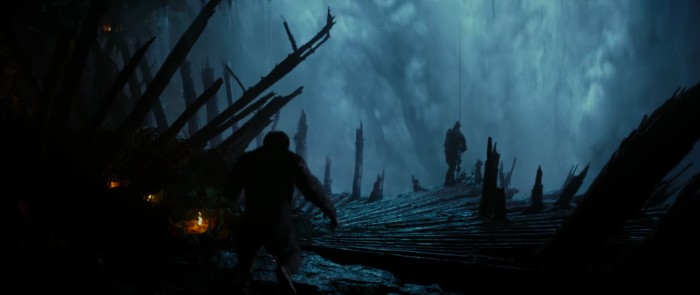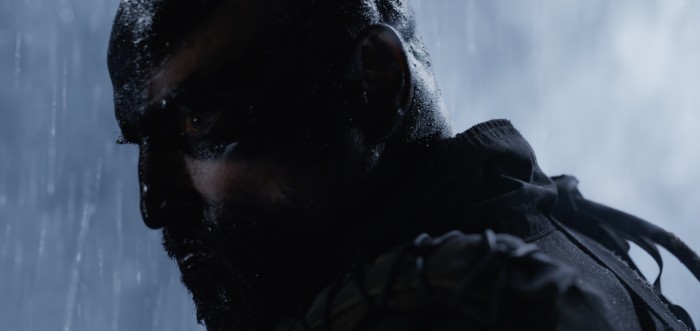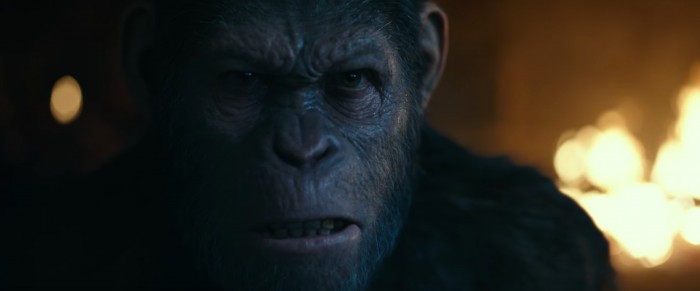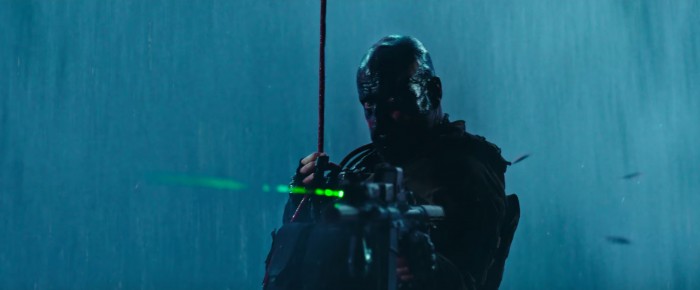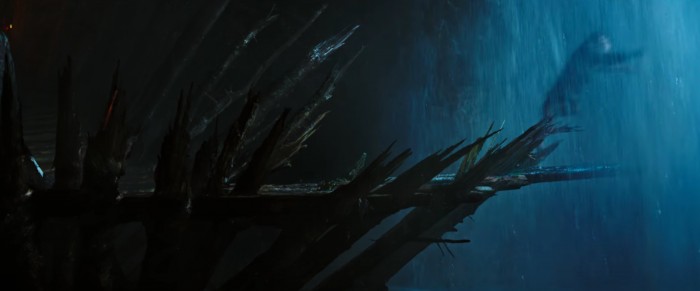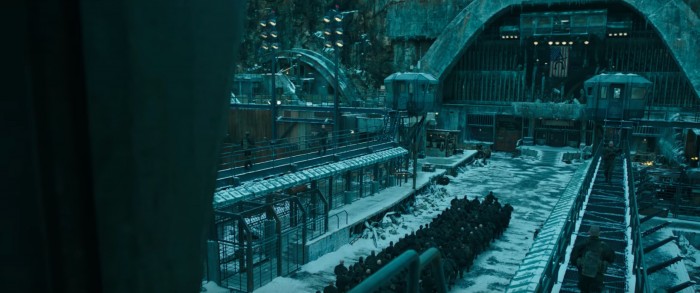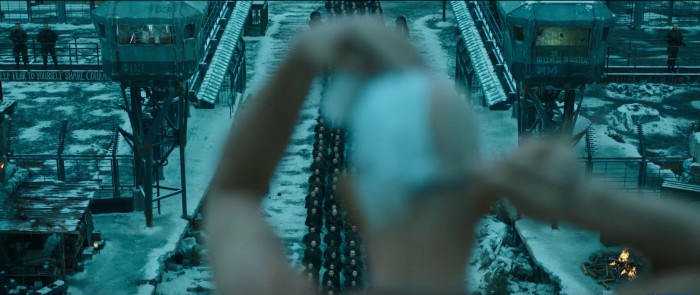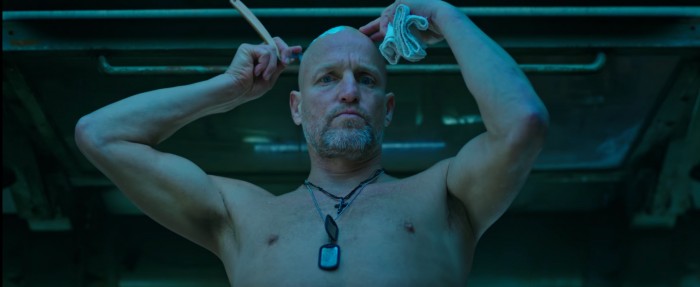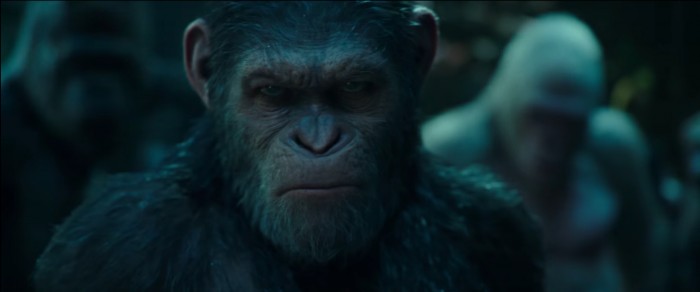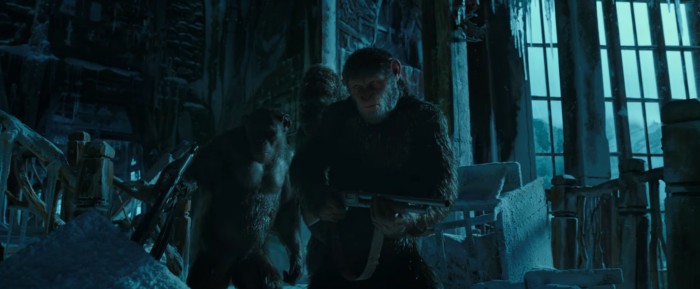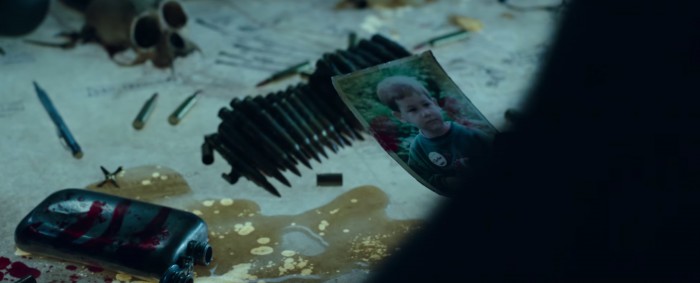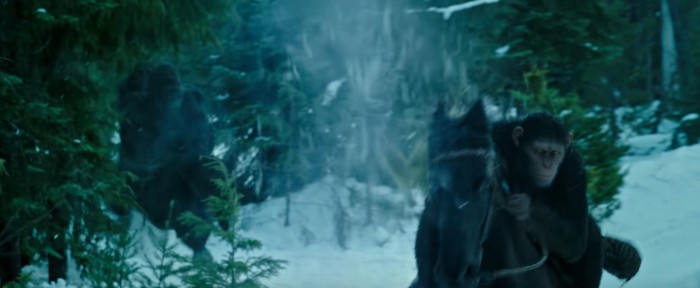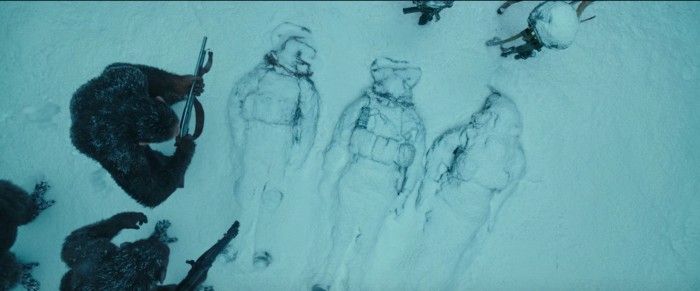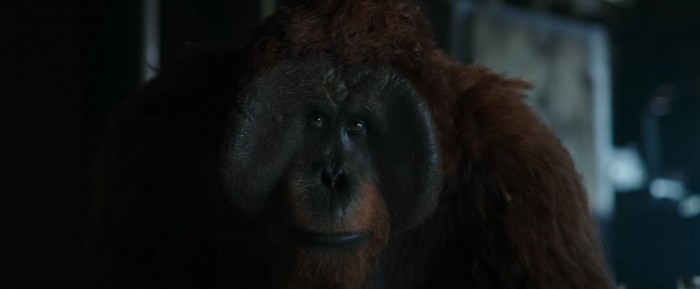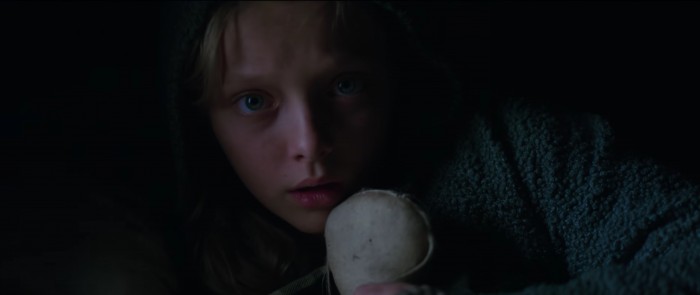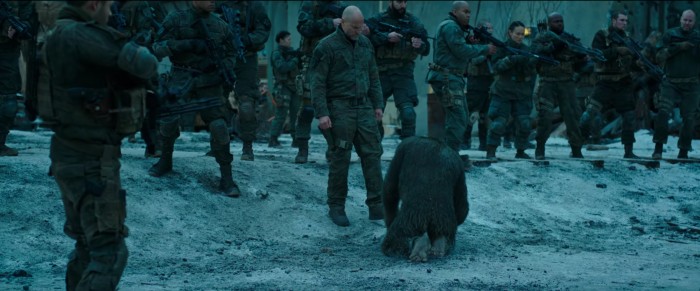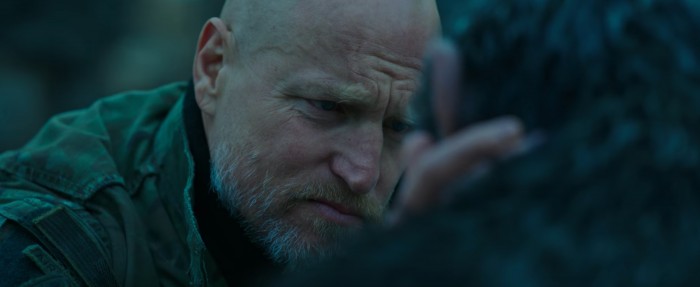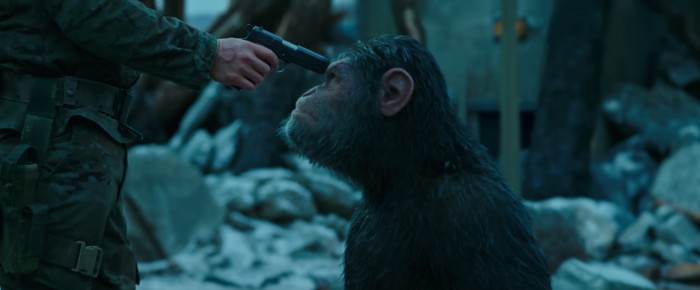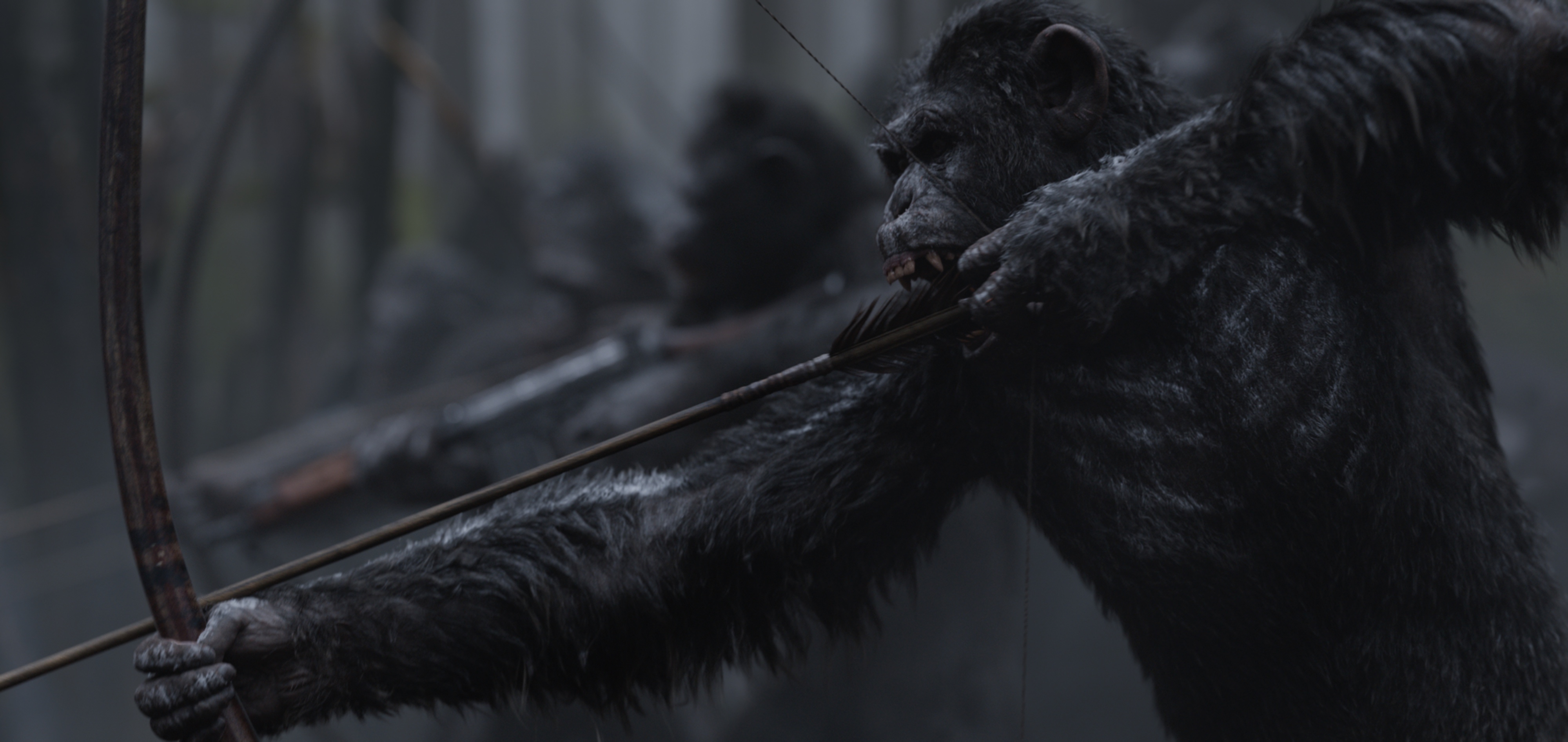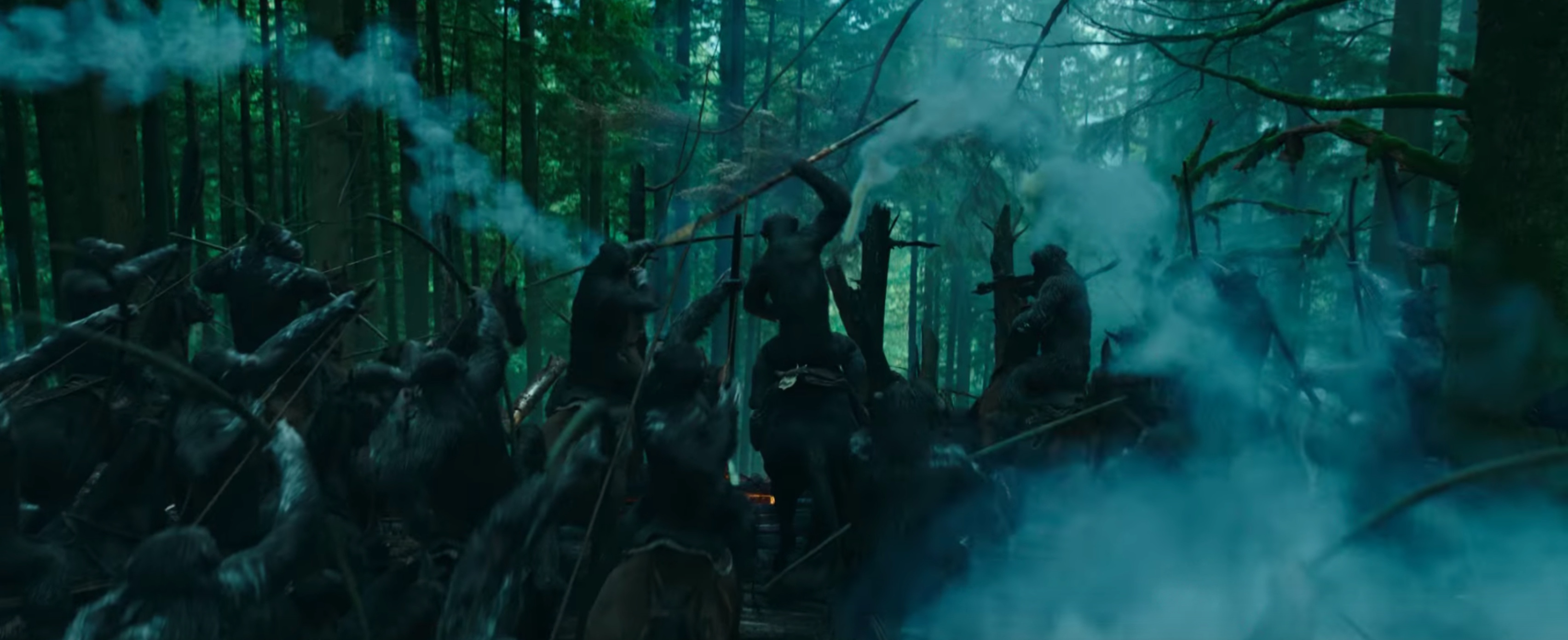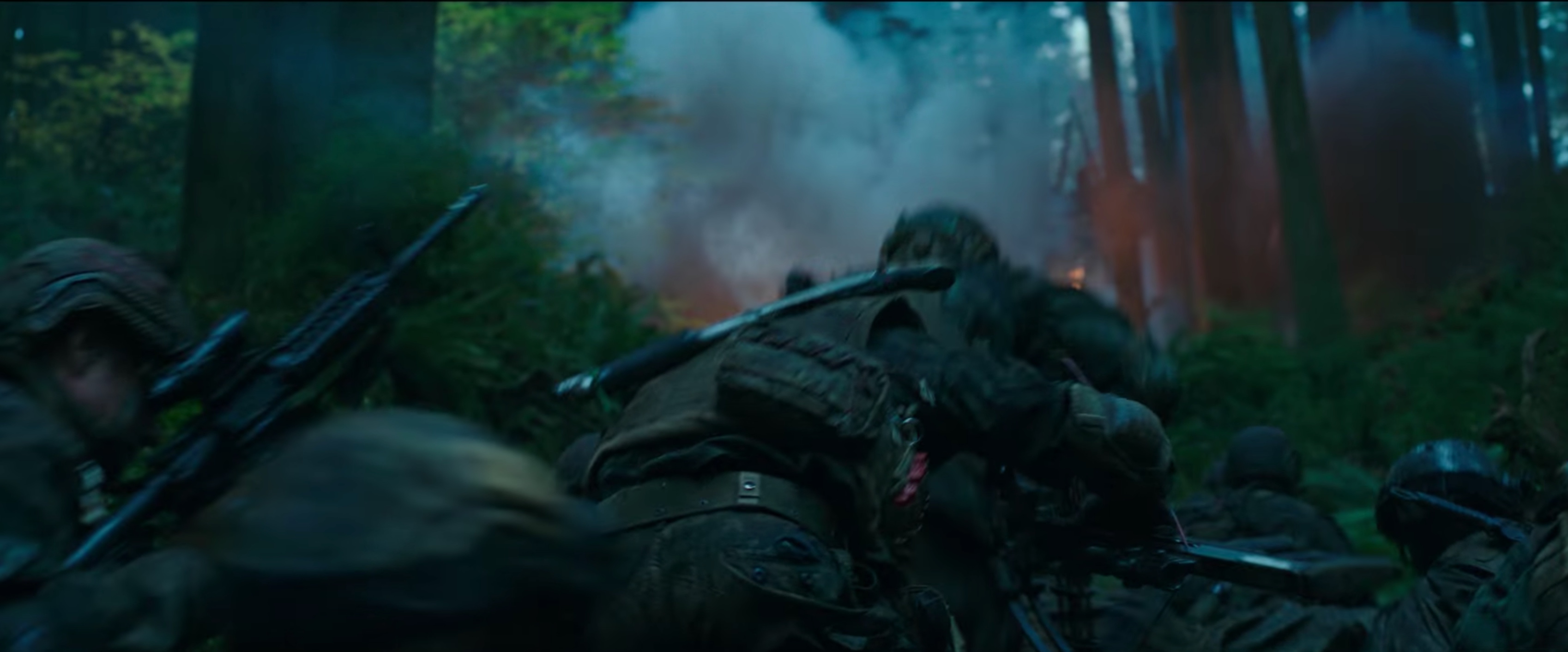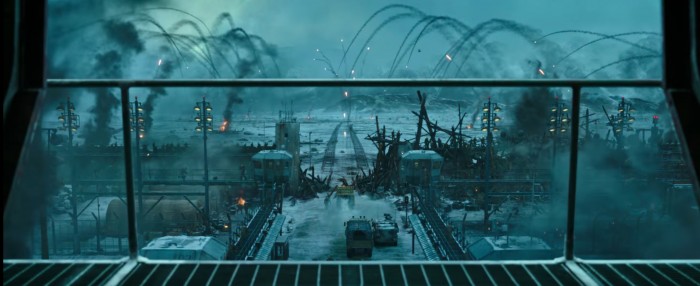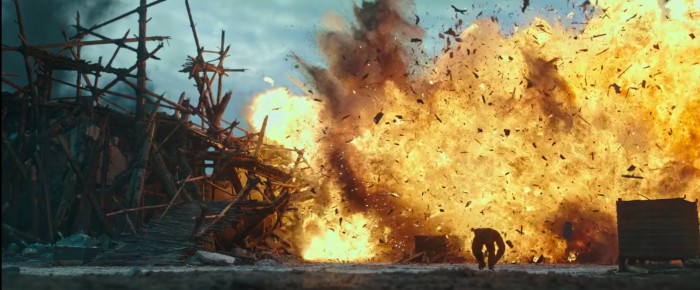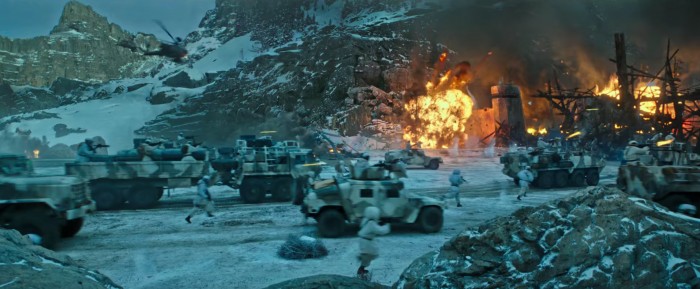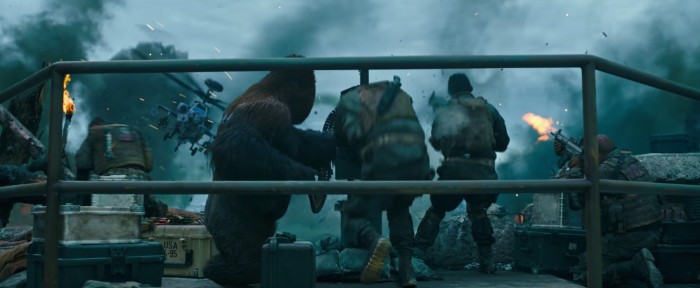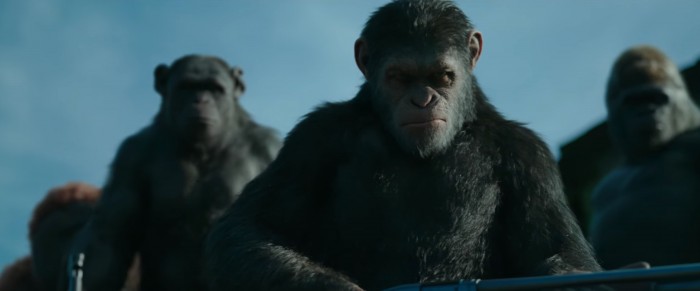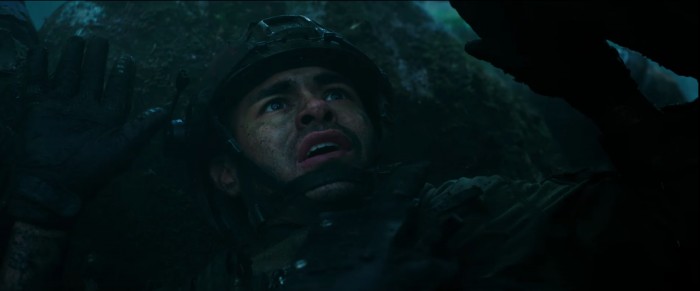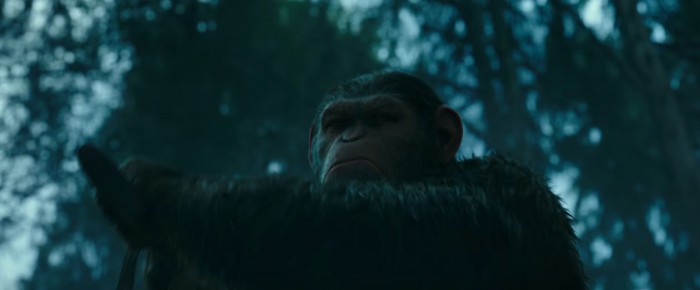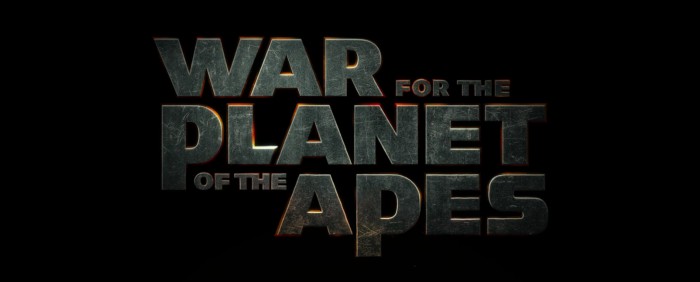'War For The Planet Of The Apes' Trailer Breakdown: Looking At The Simian Battle Frame-By-Frame
Earlier this morning, 20th Century Fox released the first trailer for Matt Reeves' War for the Planet of the Apes. Let's take a look at the trailer frame by frame and hopefully add some insight from our visit to the set. Hit the jump for the War for the Planet of the Apes trailer breakdown.
The trailer begins with a beautiful vista shot of apes on horseback riding on the edge of a beach. The filmmakers and producers have described the third Apes film as an epic western with Ceasar taking the Clint Eastwood role.
Ceasar doesn't look too happy, peering over at his fellow apes, gun strapped to his back. Star Andy Serkis explains what has brought Ceasar here:
Caesar at this point of his journey, if you remember where we left off at the last story, the apes had become divided under the leadership of Koba and he was carrying an enormous amount of guilt going against one of the primary tenets of their belief, which is that you shall not kill apes. He's killed the person who was his core [collaborator]. So two years have passed and the ALZ drug has continued to enable Caesar to develop. He's there now living in a situation where both apes and humans are at war and there's a sense that this is the crux, this is the climactic moment where both species are under huge threat and it's pretty apocalyptic. So they've weathered... both sides are worn out. Caesar's side had to leave the encampment in the woods and lead them up higher in the hills and set up a temporary base. You'll remember Caesar as a character — one of his main characteristics, having been brought up with human beings, was to be empathetic to both sides but an event happens at the beginning of this movie that sets him off on a track that almost eats him up and he does set off on a revenge mission after this event happens without giving too much away. Through this story he goes through this incredible journey very much going to the dark heart of himself, probably the darkest he's ever encountered. T
The humans believe that if they can kill Caesar, the apes head would be "cut off" and they can win this war. Caesar believes if he can kill Woody Harrelson's character The Colonel, they can win this war and let the apes start anew. But it doesn't work out that way.
What is Ceasar angry about? Producer Dylan Clark explains:
Caesar goes on a journey at the end of the first act because he doesn't believe he's fit to lead. Apes have found where they think they can live without human fighting. A promised land, so to speak. A place where they can start over. A safer, more beautiful land they can inhabit. And he goes on a dark quest. ... Caesar and his group pick up a blonde girl, a little girl — along the way and there's a great scene, they're going to leave her and she's young and not able to take care of herself and Caesar says we're not taking her and Maurice says to Caesar — I understand but I'm not leaving her. And you love Maurice. And the next cut is the little girl on the back of a horse, holding onto a big orangutan, looking at Caesar.
This time around the movie was shot on 65mm film, with the producers citing filmmakers like David Lean for their aspirations with this journey.
This story takes place two years after the events of Dawn of the Planet of the Apes, which ended with his human best friend Jason Clarke informing him that the humans made contact with another faction up north and a significant military threat is coming. Producer Dylan Clark explains the opening of this film:
So when we start this movie two years later, there's a serious thing going on. They're fighting armed forces — guys in military fatigue and assault rifles and weaponry. This isn't a ragtag group of militia.
Here we see some of that opening confrontation, with the military attacking the Ape fort.
Some of the human soldiers are captured by the Apes. Producer Dylan Clark believes that "we have the best opening of all of the [ape] movies."
Again, producer Dylan Clark explains that this war is something Ceasar is trying to come to grips with:
Caesar's had to have this horrible war against the humans — a war he didn't start. Koba started this thing. He just feels responsible for it. What happens in this because of ape losses and human losses and just chaos and pain, Caesar is at some point not fit to lead the apes and goes on a dark journey to end this war.
Big films usually employ a secret production name to keep the profile of the production lower. The production name for War for the Planet of the Apes was "Hidden Fortress," a title used on all the production materials, call sheets and even the clapper used before every shot. Why was it called Hidden Fortress? It is a reference to an important location in the film.
Producer Dylan Clark explains:
The humans have been after Caesar for some time. And as I said to you, it was very important digitally for Matt to start you guys out, start the audience out in a world that looks very familiar and then take you into a different world. The Hidden Fortress, because the apes survival depends on it, is through practical tunnels in Othello that we shot beautiful, beautiful, and then we CGI'd this waterfall. And behind that resides this kind of thing. That is a digital set. This is after apes getting killed, this is the stuff that weighs on Caesar. Beautiful, we shot up at Allowen Lake.
But the fortress is not hidden anymore.
The humans have found the Ape's hidden fortress and have come to, as Ceasar says, "finish us off."
The apes takes on the human in the arena of darkness, and the result should be a smart and thrilling action sequence from director Matt Reeves.
Ceasar approaches a man near the waterfall entrance.
You might not recognize this man at first look, but it is Woody Harrelson, who plays the film's human antagonist The Colonel. Dylan Clark explains:
He's the antagonist of the movie. Bad guy's probably selling him a little bit short. He's the antagonist 'cause he's against Caesar and what Caesar's trying to accomplish. ... He's after survival. He wants to win. And he believes that the apes stand in the way.
Dylan explains:
I think the audience has been waiting for this kind of fight to happen but I also think they don't want to just see human army vs. ape army. You can't have an entire movie of that. What I love about it — is that the journey really is the war inside of Caesar. We're in the apes' point of view. We're experiencing this movie through Caesar. Last movie — Koba took a lot of the stuff. Koba was fantastic. The narrative weight is now on Caesar's back for this one.
The Colonel fires at Ceasar before repelling down the waterfall.
We see Ceasar run and lunge at him into the water.
What we see here is a quarantine compound during the days of the simian flu. In this film, the armory up in the Sierra Mountains has been turned into a military base for human soldiers.
They have captured apes and had them rebuild architecture, a wooden gate at the front. The front has two outdoor prison yards filled with apes, basically an ape internment camp.
On Harrelson's character, Clark reveals:
Woody Harrelson is a smart character. He knows they're stronger. He knows they're faster. He knows they're as smart now. He realizes we have a big time problem. He knows they're mad. So what do you do about that when you're dealing with the virus? "
Ceasar is clearly not happy.
It appears Ceasar is leading a group of armed apes into this mountain compound.
We see a shot of The Colonel looking at a photo of a child. Perhaps this is his motivation.
Ceasar and a band of apes ride toward this snowy mountain compound.
A cool above-view framing of some human casualties in the snow.
This film is the first time any Hollywood production has done performance capture in snowy settings. Shooting in snowy locations presents a huge challenge for the visual effects team because the human actors on Ape stilts walk differently from take to take, creating completely different footpaths in the snow. The result is that the entire path in the snow will have to be digitally recreated in post.
Maurice is once again played by Karin Konoval, a 125-pound woman playing the huge 300-pound orangutan. Maurice's journey is richer, deeper and fuller. Psychologically we see him evolve. He will not leave Caesar's side, as he is Caesar's advisor, but that doesn't mean he isn't willing to challenge Caesar at times. Maurice is always assessing what the most effective thing to do in any situation, and staying away from violence until it's absolutely necessary.
Again we see Maurice protecting the young child, played by Amiah Miller, who they found on the side of the road. I'm sure her role will be significant to the story and Ceasar's journey.
Ceasar is on his knees in front of The Colonel, but the rest of the human military squad seems focused on something else, something before them. But what?
This is not something we would expect from a confrontation between these two. It appears that The Colonel is showing some empathy for Ceasar. Producer Dylan Clark explains that he isn't a "black and white" mustache twirling bad guy:
"We're looking for the gray because that's the complicated world we live in so we like to paint all our characters with very strong points of view. He has a point of view. It doesn't coincide with the ape's point of view. He's against Caesar. In a different time and a different world they might have been able to coexist. But where circumstances have brought these two to the table now in this movie, they cannot be on the same side.... Who's going to inherit the planet? Who's going to win? That's what this is about. The dominant species wins.
Will The Colonel pull the trigger and end this war with the apes?
We see shots of the Apes protecting their fort with bows and arrows, this is likely from the opening of the film.
We see a shot of the epic firefight outside of this snowy mountain compound.
A beautiful shot of an ape narrowly escaping a huge explosion.
Another shot of this huge firefight. We see the humans have a lot more resources than the apes, including tanks and...
...a helicopter.
Ceasar leading his apes in the fight against the humans.
A human begs for his life. Andy Serkis tells us that the "stakes are higher this is a much darker, much more brutal, harder, tougher, very very brutal film." He continues:
"As brutal as you can get within a PG-13. Not in an overly graphic way but in its emotions and context. There's a real sense of foreboding in this movie."
We end with Ceasar smashing the man's face with the back end of his rifle. Cut to the title card:
War for the Planet of the Apes hits theaters on July 14th, 2017.

